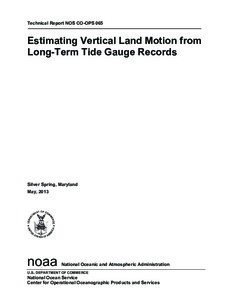| dc.contributor.author | Zervas, C. | |
| dc.contributor.author | Gill, S. | |
| dc.contributor.author | Sweet, W. | |
| dc.date.accessioned | 2018-12-12T19:16:32Z | |
| dc.date.available | 2018-12-12T19:16:32Z | |
| dc.date.issued | 2013 | |
| dc.identifier.citation | Zervas, C.; Gill, S. and Sweet, W. (2013) Estimating Vertical Land Motion from
Long-Term Tide Gauge Records. Silver Spring, MD, NOAA NOS Center for Operational Oceanographic Products and Services, 22pp. (NOAA Technical Report NOS CO-OPS 065). DOI: http://dx.doi.org/10.25607/OBP-141 | en_US |
| dc.identifier.uri | http://hdl.handle.net/11329/576 | |
| dc.identifier.uri | http://dx.doi.org/10.25607/OBP-141 | |
| dc.description.abstract | This report documents a methodology that can be used to estimate the vertical land motion
(VLM) at NOAA tide stations by performing an oceanographic analysis of the long-term data
sets. In the near future, VLM measurements will be the primary adjustment needed to locally
calibrate scenario projections of global sea level rise such as those being generated by the
National Climatic Assessment (NCA) for the US Global Climate Research Program (USGCRP).
The methodology presented here involves the decomposition of the observed relative mean sea
level data and their computed trends. It is recognized that the long-term sea level time series
observed at tide stations contains a component due to oceanography and a component due to
VLM. The oceanographic signal is not completely described by a simple global sea level trend
estimate.
The purpose of the methodology is to provide a more accurate estimation of local VLM at tide
stations with 30-60 years of data rather than just simply subtracting the estimated global sea level
trend of 1.7mm/yr from the observed relative mean sea level trend. Relative sea level trends
calculated from shorter data periods are more likely to be affected by anomalously high or low
oceanographic levels at the beginning or end of their series. By removing the regional
oceanographic variability as calculated based on longer-period stations, both more accurate and
more precise estimates of land motion are possible at shorter-period stations. | en_US |
| dc.language.iso | en | en_US |
| dc.publisher | NOAA, NOS Center for Operational Oceanographic Products and Services | en_US |
| dc.relation.ispartofseries | NOAA Technical Report NOS CO-OPS;065 | |
| dc.rights | CC0 1.0 Universal | * |
| dc.rights.uri | http://creativecommons.org/publicdomain/zero/1.0/ | * |
| dc.subject.other | Sea level changes | en_US |
| dc.subject.other | Tide gauges | |
| dc.title | Estimating Vertical Land Motion from Long-Term Tide Gauge Records. | en_US |
| dc.type | Report | en_US |
| dc.description.status | Published | en_US |
| dc.format.pages | 22pp. | en_US |
| dc.description.refereed | Refereed | en_US |
| dc.publisher.place | Silver Spring, MD | en_US |
| dc.rights.license | Public Domain | |
| dc.description.currentstatus | Current | en_US |
| dc.description.eov | Sea surface height | en_US |
| dc.description.bptype | Best Practice | en_US |
| dc.description.bptype | Guide | en_US |
| obps.contact.contactemail | coops.webmaster@noaa.gov | |
| obps.resourceurl.publisher | https://tidesandcurrents.noaa.gov/pub.html | en_US |
 Repository of community practices in Ocean Research, Applications and Data/Information Management
Repository of community practices in Ocean Research, Applications and Data/Information Management

